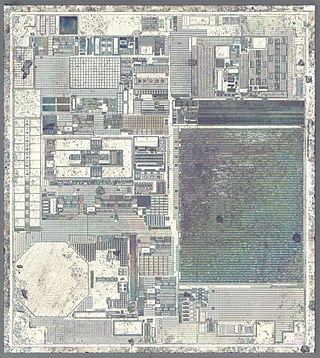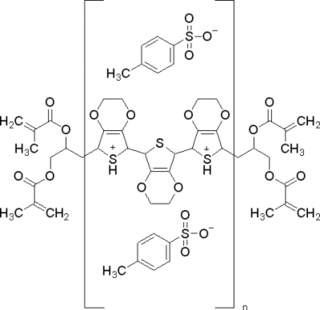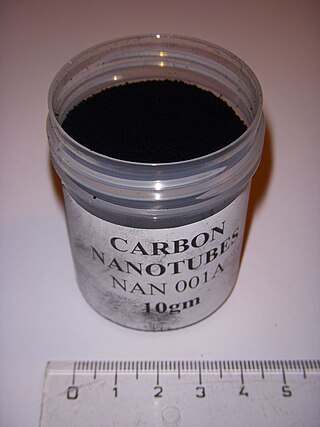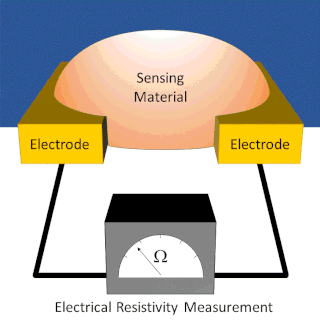Related Research Articles

A carbon nanotube (CNT) is a tube made of carbon with a diameter in the nanometer range (nanoscale). They are one of the allotropes of carbon.

A composite material is a material which is produced from two or more constituent materials. These constituent materials have notably dissimilar chemical or physical properties and are merged to create a material with properties unlike the individual elements. Within the finished structure, the individual elements remain separate and distinct, distinguishing composites from mixtures and solid solutions.

Nanoelectromechanical systems (NEMS) are a class of devices integrating electrical and mechanical functionality on the nanoscale. NEMS form the next logical miniaturization step from so-called microelectromechanical systems, or MEMS devices. NEMS typically integrate transistor-like nanoelectronics with mechanical actuators, pumps, or motors, and may thereby form physical, biological, and chemical sensors. The name derives from typical device dimensions in the nanometer range, leading to low mass, high mechanical resonance frequencies, potentially large quantum mechanical effects such as zero point motion, and a high surface-to-volume ratio useful for surface-based sensing mechanisms. Applications include accelerometers and sensors to detect chemical substances in the air.
Phaedon Avouris is a Greek chemical physicist and materials scientist. He is an IBM Fellow and was formerly the group leader for Nanometer Scale Science and Technology at the Thomas J. Watson Research Center in Yorktown Heights, New York.

Nanocomposite is a multiphase solid material where one of the phases has one, two or three dimensions of less than 100 nanometers (nm) or structures having nano-scale repeat distances between the different phases that make up the material.

Carbon nanotubes (CNTs) are cylinders of one or more layers of graphene (lattice). Diameters of single-walled carbon nanotubes (SWNTs) and multi-walled carbon nanotubes (MWNTs) are typically 0.8 to 2 nm and 5 to 20 nm, respectively, although MWNT diameters can exceed 100 nm. CNT lengths range from less than 100 nm to 0.5 m.

Graphene nanoribbons are strips of graphene with width less than 100 nm. Graphene ribbons were introduced as a theoretical model by Mitsutaka Fujita and coauthors to examine the edge and nanoscale size effect in graphene.

Poly(3,4-ethylenedioxythiophene)-tetramethacrylate or PEDOT-TMA is a p-type conducting polymer based on 3,4-ethylenedioxylthiophene or the EDOT monomer. It is a modification of the PEDOT structure. Advantages of this polymer relative to PEDOT are that it is dispersible in organic solvents, and it is non-corrosive. PEDOT-TMA was developed under a contract with the National Science Foundation, and it was first announced publicly on April 12, 2004. The trade name for PEDOT-TMA is Oligotron. PEDOT-TMA was featured in an article entitled "Next Stretch for Plastic Electronics" that appeared in Scientific American in 2004. The U.S. Patent office issued a patent protecting PEDOT-TMA on April 22, 2008.

Linear acetylenic carbon (LAC), also known as carbyne or Linear Carbon Chain (LCC), is an allotrope of carbon that has the chemical structure (−C≡C−)n as a repeat unit, with alternating single and triple bonds. It would thus be the ultimate member of the polyyne family.
Polymer nanocomposites (PNC) consist of a polymer or copolymer having nanoparticles or nanofillers dispersed in the polymer matrix. These may be of different shape, but at least one dimension must be in the range of 1–50 nm. These PNC's belong to the category of multi-phase systems that consume nearly 95% of plastics production. These systems require controlled mixing/compounding, stabilization of the achieved dispersion, orientation of the dispersed phase, and the compounding strategies for all MPS, including PNC, are similar. Alternatively, polymer can be infiltrated into 1D, 2D, 3D preform creating high content polymer nanocomposites.

The mechanical properties of carbon nanotubes reveal them as one of the strongest materials in nature. Carbon nanotubes (CNTs) are long hollow cylinders of graphene. Although graphene sheets have 2D symmetry, carbon nanotubes by geometry have different properties in axial and radial directions. It has been shown that CNTs are very strong in the axial direction. Young's modulus on the order of 270 - 950 GPa and tensile strength of 11 - 63 GPa were obtained.

The optical properties of carbon nanotubes are highly relevant for materials science. The way those materials interact with electromagnetic radiation is unique in many respects, as evidenced by their peculiar absorption, photoluminescence (fluorescence), and Raman spectra.

Rodney S. "Rod" Ruoff is an American physical chemist and nanoscience researcher. He is one of the world experts on carbon materials including carbon nanostructures such as fullerenes, nanotubes, graphene, diamond, and has had pioneering discoveries on such materials and others. Ruoff received his B.S. in chemistry from the University of Texas at Austin (1981) and his Ph.D. in chemical physics at the University of Illinois-Urbana (1988). After a Fulbright Fellowship at the MPI fuer Stroemungsforschung in Goettingen, Germany (1989) and postdoctoral work at the IBM T. J. Watson Research Center (1990–91), Ruoff became a staff scientist in the Molecular Physics Laboratory at SRI International (1991–1996). He is currently UNIST Distinguished Professor at the Ulsan National Institute of Science and Technology (UNIST), and the director of the Center for Multidimensional Carbon Materials, an Institute for Basic Science Center located at UNIST.

Ajay Kumar Sood is an Indian physicist and researcher currently serving as the 4th Principal Scientific Adviser to the Government of India.

A chemiresistor is a material that changes its electrical resistance in response to changes in the nearby chemical environment. Chemiresistors are a class of chemical sensors that rely on the direct chemical interaction between the sensing material and the analyte. The sensing material and the analyte can interact by covalent bonding, hydrogen bonding, or molecular recognition. Several different materials have chemiresistor properties: metal-oxide semiconductors, some conductive polymers, and nanomaterials like graphene, carbon nanotubes and nanoparticles. Typically these materials are used as partially selective sensors in devices like electronic tongues or electronic noses.

Boron nitride nanosheet is a two-dimensional crystalline form of the hexagonal boron nitride (h-BN), which has a thickness of one to few atomic layers. It is similar in geometry as well as physical and thermal properties to its all-carbon analog graphene, but has very different chemical and electronic properties – contrary to the black and highly conducting graphene, BN nanosheets are electrical insulators with a band gap of ~5.9 eV, and therefore appear white in color.
In materials science, a polymer matrix composite (PMC) is a composite material composed of a variety of short or continuous fibers bound together by a matrix of organic polymers. PMCs are designed to transfer loads between fibers of a matrix. Some of the advantages with PMCs include their light weight, high resistance to abrasion and corrosion, and high stiffness and strength along the direction of their reinforcements.
A graphene helix, similar to the carbon nanotube, is a structure consisting of a two-dimensional sheet of graphene wrapped into a helix. These graphene sheets can have multiple layers, called multi-walled carbon structures, that add to these helices thus increasing their tensile strength but increasing the difficulty of manufacturing. Using van der Waals interactions it can make structures within one another.

Alan Kin-tak Lau is an engineer and academic based in Hong Kong SAR. He is the President and Chair Professor of Product Innovation at Technological and Higher Education Institute (Thei) of Hong Kong. Prior to this appointment, he was Pro Vice-Chancellor at Swinburne University of Technology. He is also the Independent Non-Executive Director of King’s Flair International (Holdings) Limited, the International Vice President and Trustee Board member of The Institution of Mechanical Engineers (2014-2019) and an Academic Advisor at Asia University. He was also appointed the Chair of professional accreditation panel for APEC/IPEA for Korea. From 2014 to 2016, he was the Alex Wong/Gigi Wong Endowed Professor in Product Engineering Design at the Hong Kong Polytechnic University (HPKU). Currently, he is a Fellow of European Academy of Sciences and Arts, the European Academy of Sciences. Lau has conducted research in the field of Mechanical Engineering, Aerospace Engineering and Materials Engineering. His work has been focused on aerospace composites, Unmanned aerial vehicle, product design and engineering and bio-composites. Lau is recognized as Australian National Research Leader in Composite Materials 2019, published by The Australian Post. Within the period 2020-2022, he was Director of Oceania Cybersecurity Centre Limited and Stawell Underground Physics Laboratory Company.

Andrea Carlo Ferrari is a professor of nanotechnology at the University of Cambridge.
References
- 1 2 3 Anon (2017). "Young, Prof. Robert Joseph" . Who's Who (online ed.). A & C Black. doi:10.1093/ww/9780199540884.013.41403 . Retrieved 2017-12-17.(Subscription or UK public library membership required.)
- ↑ Kinlock, A.J.; Young, R.J. (2014). Fracture Behaviour of Polymers Paperback. Springer. ISBN 978-9401715959.
- ↑ Young, Robert (2011). Introduction to polymers. Boca Raton: CRC Press. ISBN 978-0-8493-3929-5.
- 1 2 3 4 5 Anon (2013). "Robert Young". royalsociety.org. London: Royal Society. One or more of the preceding sentences incorporates text from the royalsociety.org website where:
“All text published under the heading 'Biography' on Fellow profile pages is available under Creative Commons Attribution 4.0 International License.” -- "Royal Society Terms, conditions and policies". Archived from the original on 2016-11-11. Retrieved 2016-03-09.
{{cite web}}: CS1 maint: bot: original URL status unknown (link) - ↑ Young, Robert Joseph (1972). Deformation mechanism in crystalline polymers. repository.cam.ac.uk (PhD thesis). University of Cambridge. OCLC 183326728. EThOS uk.bl.ethos.478386.
- 1 2 Robert Joseph Young ORCID 0000-0001-6073-9489
- ↑ Robert Young publications indexed by the Scopus bibliographic database. (subscription required)
- ↑ Robert Young publications indexed by Google Scholar
- ↑ Young, Robert J.; Liu, Mufeng; Kinloch, Ian A.; Li, Suhao; Zhao, Xin; Vallés, Cristina; Papageorgiou, Dimitrios G. (January 2018). "The mechanics of reinforcement of polymers by graphene nanoplatelets". Composites Science and Technology. 154: 110–116. doi: 10.1016/j.compscitech.2017.11.007 .
- ↑ Young, Robert J.; Lovell, Peter A. (2011). Introduction to Polymers. doi:10.1201/9781439894156. ISBN 9781439894156.
- ↑ Anon (2013). "EC/2013/44: Young, Robert Joseph". royalsociety.org. Royal Society . Retrieved 22 December 2017.
![]() This article incorporates text available under the CC BY 4.0 license.
This article incorporates text available under the CC BY 4.0 license.